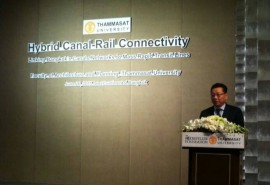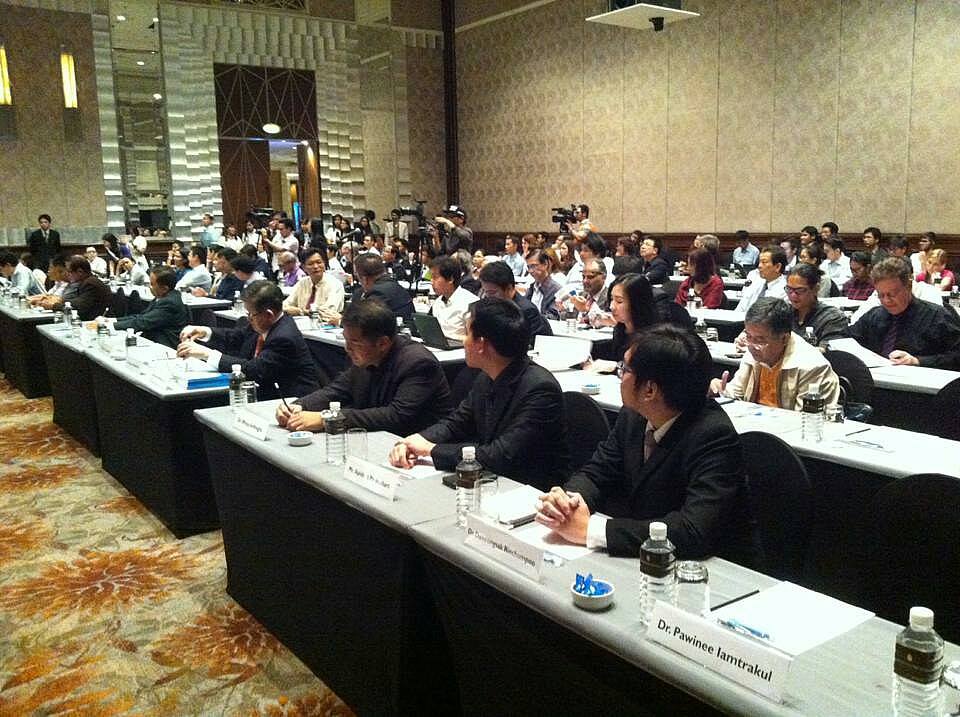
A conference on the development of water and rail transit networks “Hybrid CanalRail Connectivity: Linking Bangkok’s Canal Networks to Mass Rapid Transit Lines” was organized by the Research Team of Faculty of Architecture and Planning, Thammasat University, Bangkok Metropolitan Administration (BMA) and the Rockefeller Foundation, Thailand on 26 June 2015. This conference focused on the current practices, research implications, future challenges and solutions to improve the canalrail connectivity specifically in Bangkok. Dr. Naveed Anwar and Ms. Rakdao Pakdisi attended the conference on behalf of AIT Consulting.
 Bangkok is a mega-city with a population of over 10 million. The average Bangkokian spends 4 hours in traffic jam – half of their productive work life. This leads to high anxiety level combined with high environmental problems. Resurrecting the ancient canal networks could help alleviate Bangkok’s connectivity’s problem, free up commuting time for its residents, and develop new economic activities. This seminar was organized to address these issues and propose solutions to improve the canal-rail connectivity in Bangkok.
Bangkok is a mega-city with a population of over 10 million. The average Bangkokian spends 4 hours in traffic jam – half of their productive work life. This leads to high anxiety level combined with high environmental problems. Resurrecting the ancient canal networks could help alleviate Bangkok’s connectivity’s problem, free up commuting time for its residents, and develop new economic activities. This seminar was organized to address these issues and propose solutions to improve the canal-rail connectivity in Bangkok.
The Deputy Governor of Bangkok Amorn Kitchawengkul presided over the seminar and said that this research reveals corresponding information with the BMA’s bus, rail, and boat transport integration project that was initiated by the Bangkok Governor Sukhumbhand Paribatra. The Bangkok Deputy Governor mentioned that the Bangkok’s transportation integration plan was pursuing the same direction as the studies by Thammasat University. Mr. Yanyong Boon-Long and his team described the research implications and future challenges. They were of the view that in terms of the Bangkok’s overall connectivity, such hybrid linkages of canals and metro transit would provide rapid – and random – long distant “jump” across the city, a phenomenon that could not be provided by any one type of transit system alone. They discussed the potential opportunities that Hybrid Canal-Rail Connectivity could bring to the investors such as: Retail Shops at Canal-Metro Stations (these canal-to-Metro stations could act as catalysts in regenerating the much needed economic activities and jobs for the informal settlements along the canals.
They would also enable informal residents to gain faster access to healthcare facilities and service along rail lines that were previously out of their reach); Community Ports (local “Community ports” could be set up along the canals to transport small cargo. Small consumer goods and products could be delivered continuously throughout the day – unlike automobile transport which is limited by fixed delivery time in the early morning or night time); New Fleet of Boats (investment should be made in new enclosed boats that are safe and accessible to seniors and working professionals. People should be able to work while in transit –similar to being in a subway).

